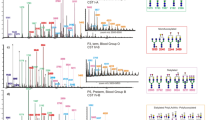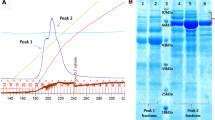Abstract
The present knowledge concerning the glycan structures and role of glycoconjugates derived from amniotic fluid is fragmentary and mainly focuses on the individual glycoproteins. The question has arisen as whether the general glycosylation pattern of amniotic fluid glycoconjugates can change with the progression of a normal pregnancy. In the present work we have described the dynamic, quantitative alterations in relative amounts of sialic acid and fucose linked by a variety of anomeric linkages to subterminal oligosaccharide structures of amniotic fluid glycoconjugates in relation to pregnancy age. The analysis was performed in the following groups of amniotic fluids derived from normal pregnancy by lectin dotting method: “2nd trimester” (14–19 weeks), “3rd trimester” (29–37 weeks), “perinatal period” (38–40 weeks) , “delivery at term” (39–41 weeks) and “post date pregnancy” (41–43 weeks). In the “3rd trimester” the amniotic fluid glycoconjugates contained higher relative amounts of glycans terminated by α2-6-linked sialic acid (p < 0.00002) and by α1-6 innermost fucose (p < 0.000001) than those in the 2nd trimester. In contrast, they showed the lower relative amount of fucose linked α1-3 (p < 0.02). At the perinatal period the relative amount of α2-6-linked sialic acid increased (p < 0.03), and it then decreased during delivery (p < 0.02) to the level found in the “3rd trimester” group. In the post date pregnancy all parameters studied increased. The sialyl- and fucosyl-glycotopes of the amniotic fluid glycoconjugates may play an critical role in growth and tissue remodeling of the foetus, as well as may might reflect maturation of a foetus. Additionally, a determination of the glycotope expressions might be helpful in prenatal diagnosis as predictor factors for well being of mother and child.
Similar content being viewed by others
Abbreviations
- AAA:
-
Aleuria Aurantia Lectin
- MAA:
-
Maackia amurensis lectin
- SNA:
-
Sambucus nigra lectin
- LTA:
-
Tetragonolobus purpureus lectin
- UEA:
-
Ulex europaeus lectin
References
Sedor FA, Body fluid analysis. In Clinical Chemistry: Principles, Procedures, Correlations, edited by Bishop ML, Duben-Engelkirk JL, Fody EP (Lippincott Williams & Willkins, Philadelphia, 2000), pp. 477–89.
Anderson SC, Endocrinology. In Clinical Chemistry: Principles, Procedures, Correlations, edited by Bishop ML, Duben-Engelkirk JL, Fody EP (Lippincott, Williams & Willkins, Philadelphia, 2000), pp. 396–397.
Mussap M, Fanos V, Piccoli A, Zaninotto M, Padovani EM, Plebani M, Low molecular mass proteins and urinary enzymes in amniotic fluid of healthy pregnant women at progressive stages of gestation, Clin Biochem 29, 51–6 (1996).
Hanisch FG, Peter-Katalinic J, Structural studies on fetal mucins from human amniotic fluid. Core typing of short-chain O-linked glycans, Eur J Biochem 205, 527–35 (1992).
Skarulis MC, Wehmann RE, Nisula BC, Blithe DL, Glycosylation changes in human chorionic gonadotropin and free alpha subunit as gestation progresses, J Clin Endocrinol Metab 75, 91–6 (1992).
Nemansky M, Thotakura NR, Lyons CD, Ye S, Reinhold BB, Reinhold VN, Blithe DL, Developmental changes in the glycosylation of glycoprotein hormone free α subunit during pregnancy, J Biol Chem 273, 12068–76 (1998).
Harirah H, Donia SE, Hsu Ch-D, Amniotic fluid matrix metalloproteinase-9 and interleukin-6 in predicting intra-amniotic infection, Obstet. Gynecol. 99, 80–4 (2002).
Durand G, Seta N, Protein glycosylation and diseases: blood and urinary oligosaccharides as markers for diagnosis and therapeutic monitoring, Clin. Chem. 46, 795–805 (2000).
Rüdiger H, Siebert H-Ch, Solis D, Jimènez-Barbero J, Romero A, Von der Lieth C-W, Diaz-Mauriño T, Gabius H-J, Medical chemistry based on the sugar code: Fundamentals of lectinology and experimental strategies with lectins as targets, Curr Med Chem 7, 389–416 (2000).
Clark GF, Oehninger S, Patankar MS, Koistinen R, Dell A, Morris HR, Koistinen H, Seppala M, A role for glycoconjugates in human development: the human feto-embryonic defence system hypothesis, Hum. Reprod. 11, 467–70 (1996).
Muramatsu T, Muramatsu H, Carbohydrate antigens expressed on stem cells and early embryonic cells, Glycoconjugate J 21, 41–5 (2004).
Van Dijk W, Turner GA, Mackiewicz A, Changes in glycosylation of acute-phase proteins in health and disease: occurrence, regulation and function; Glycosylation Dis. 1, 5–14 (1994).
Carson DD, Farrar JD, Laidlaw J, Wright DA, Selective activation of the N-glycosylation apparatus in uteri by estrogen, J Biol Chem 265, 2947–55 (1990).
Kelm S, Schauer R, Sialic acids in molecular and cellular interactions, Int Rev Cytol 175, 137–240 (1997).
Becker DJ, Lowe JB, Fucose: biosynthesis and biological function in mammals, Glycobiology 13, 41–53 (2003).
Smith P K, Krohn RI, Hermanson G T, Makia AK, Gartner F H, Provwnzano M D, Fujimoto E K, Goeke NM, Olson B J, Kleuk D C, Measurement of protein using bicinchonic acid, Anal Biochem 150, 1530–9 (1985).
Kątnik I, Jadach J, Krotkiewski H, Gerber J, Investigating the glycosylation of normal and ovarian cancer haptoglobins using digoxigenin-labeled lectins, Glycosylation and Dis, 1, 97–104 (1994).
Bowen JM, Chamley L, Keelan JA, Mitchell MD, Cytokines of the placenta and extra-placental membranes: roles and regulation during human pregnancy and parturition, Placenta 23, 257–73 (2002).
Briese V, Kunkel S, Plath C, Wutzke KD, Plesse R, Sialic acid, steroids and proteohormones in maternal, cord and retroplacental blood, Z. Geburtshilfe Neonatol 203, 63–8 (1999).
Van Dijk W, Brinkman-van der Linden EC, Havenaar EC, Occurrence and possible function of inflammation-induced expression of sialyl Lewis-x on acute-phase proteins; Adv Exp Med Biol 435, 145–50 (1998).
Grosso M, Vitarelli E, Giuffre G, Tuccari G, Barresi G, Expression of Tn, sialosyl-Tn and T antigens in human foetal large intestine, Eur J Histochem 44, 359–63 (2000).
Hampel DJ, Köttgen B, Dudenhausen JW, Köttgen E, Fetal fibronectin as a marker for an imminent (preterm) delivery. A new technique using the glycoprotein lectin immunosorbent assay, J. Immunol. Methods 224, 31–42 (1999).
Orczyk-Pawił owicz M, Hirnle L, Ktnik-Prastowska I, Alterations of N-glycan branching and expression of sialic acid on amniotic fluid alpha-1-acid glycoprotein derived from 2nd and 3rd trimester of normal and prolonged pregnancies Arch Immunol Ther Exp 53, (2005) (in press).
Leitich H, Egarter C, Kaider A, Hohlagschwandtner M, Berghammer P, Husslein P, Cervicovaginal fetal fibronectin as a marker for preterm delivery: A meta-analysis, Am J Obstet Gynecol 180, 1169–76 (1998).
Jones CJP, Kimber SJ, Illingworth I, Aplin JD, Decidual sialylation shows species-specific differences in the pregnant mouse and rat, J Reprod Fertil 106, 241–50 (1996).
Kossowska B, Ferens-Sieczkowska M, Garncarz R, Passowicz-Muszyńska E, Jankowska R, Fucosylation of serum glycoproteins in lung cancer patients, Clin Chem Lab Med 43, 361–69 (2005).
Van Rooijen JJM, Jeschke U, Kamerling JP, Vliegenthart JF, Expression of N-linked sialyl Le(x) determinants and O-glycans in the carbohydrate moiety of human amniotic fluid transferrin during pregnancy, Glycobiology 8, 1053–1064 (1998).
Vallejo V, Reyes-Leyva J, Hernandez J, Ramirez H, Delannoy P, Zenteno E, Differential expression of sialic acid on porcine organs during the maturation process, Comp Biochem Physiol B 126, 415–24 (2000).
Koistinen H, Easton RL, Chiu PCN, Chalabi S, Halttunen M, Dell A, Morris HR, Yeung WSB, Seppala M, Koistinen R, Differences in glycosylation and sperm-egg binding inhibition of pregnancy-related glycodelin, Biol Reprod 69, 1545–51, (2003).
Schwartz-Albiez R, Merling A, Martin S, Haas R, Gross H-J, Cell surface sialylation and ecto-sialyltransferase activity of human CD34 progenitors from peripheral blood and bone marrow, Glycoconjugate J 21, 451–9 (2004).
Crocker PR, Varki A, Siglecs, sialic acids and innate immunity, Trends in Immunology 22, 337–42 (2001).
Jeschke U, Stahn R, Goletz C, Wang XY, Briese V, Friese K, HCG in trophoblast tumour cells of the cell line Jeg3 and hCG isolated from amniotic fluid and serum of pregnant women carry oligosaccharides of the sialyl Lewis x and sialyl Lewis a type, Anticancer Research 23, 1087–92 (2003).
Jeschke U, Xiaoyu W, Volker B, Friese K, Stahn R, Glycodelin and amniotic fluid transferrin as inhibitors of E-selectin-mediated cell adhesion, Histochem Cell Biol 119, 345–54 (2003).
De Graaf TW., Van der Stelt ME, Anbergen MG, Van Dijk W, Inflammation induced expression of sialyl Lewis X-containing glycan structures on α1-acid glycoprotein (orosomucoid) in human sera, J Exp Med 177, 657–66 (1993).
Knibbs R, Goldstein IJ., Ratcliff RM, Shibuya N, Characterization of the carbohydrate binding specificity of the leukoagglutinating lectin from Maackia amurensis. Comparison with other sialic acid-specific lectins, J Biol Chem 266, 83–88 (1991).
Shibuya N, Goldstein IJ, Broekaert WF, Nsimba-Lubaki M, Peeters B, Peumans WJ, The elderberry (Sambucus nigra L.) bark lectin recognizes the Neu5Ac(α2,6)Gal/GalNAc sequence, J Biol Chem 262, 1596–601 (1987).
Yamashita K, Kochibe N, Ohkura T, Ueda I, Kobata A, Fractionation of L-fucose-containing oligosaccharides on immobilized Aleuria aurantia lectin, J Biol Chem 260, 4688–93 (1985).
Yan L, Wilkins PP, Alvarez-Manilla G, Do SI, Smith DF, Cummings RD, Immobilized Lotus tetragonolobus agglutinin binds oligosaccharides containing the Lex determinant, Glycoconjugate J 14, 45–55 (1997).
Audette GF, Vandonselaar M, Delbaere LTJ, The 2.2 Å resolution structure of the O(H) blood-group-specific Lectin I from Ulex europaeus, J Mol Biol 304, 423–33 (2000).
Author information
Authors and Affiliations
Corresponding author
Rights and permissions
About this article
Cite this article
Orczyk-Pawiłowicz, M., Floriański, J., Zalewski, J. et al. Relative amounts of sialic acid and fucose of amniotic fluid glycoconjugates in relation to pregnancy age. Glycoconj J 22, 433–442 (2005). https://doi.org/10.1007/s10719-005-4437-5
Received:
Revised:
Accepted:
Issue Date:
DOI: https://doi.org/10.1007/s10719-005-4437-5




